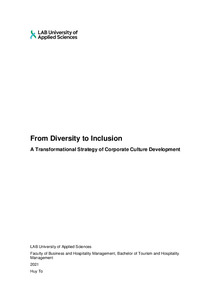From diversity to inclusion : a transformational strategy of corporate culture development
To, Huy (2021)
Avaa tiedosto
Lataukset:
To, Huy
2021
All rights reserved. This publication is copyrighted. You may download, display and print it for Your own personal use. Commercial use is prohibited.
Julkaisun pysyvä osoite on
https://urn.fi/URN:NBN:fi:amk-2021120924794
https://urn.fi/URN:NBN:fi:amk-2021120924794
Tiivistelmä
The main objectives of this thesis were to determine why inclusion should be prioritised over diversity as regards organisational culture development and to find out ways by which organisations could use inclusion as a tool to improve their organisational cultures.
The thesis consists of a theoretical framework in which key concepts and phenomena of the topic such as corporate culture, diversity in the workplace, inclusion in the workplace, differences between diversity and inclusion, multilevel perspectives on inclusion, and Inclusion Equation were explained. The theoretical framework was done with the help of various sources namely books, articles, journals, websites, and previous studies. The thesis also consists of an empirical part in which research was carried out using both quantitative and qualitative research methods that complemented each other. Quantitative research method was employed to collect data from students’ perspectives as employees or future job seekers in the tourism and hospitality industry to evaluate how they perceive different diversity- and inclusion-related elements. Qualitative research method was utilised to gather data from managers’ perspectives to gain a deeper insight into implementation of inclusion and the needs raised by inclusion challenges.
The results of the thesis indicate that inclusion must be cultivated subsequent to diversity efforts in order to maintain a sustainable corporate culture. There is an urgent need of inclusion trainings because of its importance being underestimated. Inclusion Equation could act as a reference for organisations to take a closer look at what elements of inclusion they need to focus on. The thesis also suggests a so-called Inclusion Assessment Grid developed by the thesis author. This assessment grid could be a navigator which helps organisations evaluate their own inclusion efforts.
The thesis consists of a theoretical framework in which key concepts and phenomena of the topic such as corporate culture, diversity in the workplace, inclusion in the workplace, differences between diversity and inclusion, multilevel perspectives on inclusion, and Inclusion Equation were explained. The theoretical framework was done with the help of various sources namely books, articles, journals, websites, and previous studies. The thesis also consists of an empirical part in which research was carried out using both quantitative and qualitative research methods that complemented each other. Quantitative research method was employed to collect data from students’ perspectives as employees or future job seekers in the tourism and hospitality industry to evaluate how they perceive different diversity- and inclusion-related elements. Qualitative research method was utilised to gather data from managers’ perspectives to gain a deeper insight into implementation of inclusion and the needs raised by inclusion challenges.
The results of the thesis indicate that inclusion must be cultivated subsequent to diversity efforts in order to maintain a sustainable corporate culture. There is an urgent need of inclusion trainings because of its importance being underestimated. Inclusion Equation could act as a reference for organisations to take a closer look at what elements of inclusion they need to focus on. The thesis also suggests a so-called Inclusion Assessment Grid developed by the thesis author. This assessment grid could be a navigator which helps organisations evaluate their own inclusion efforts.
